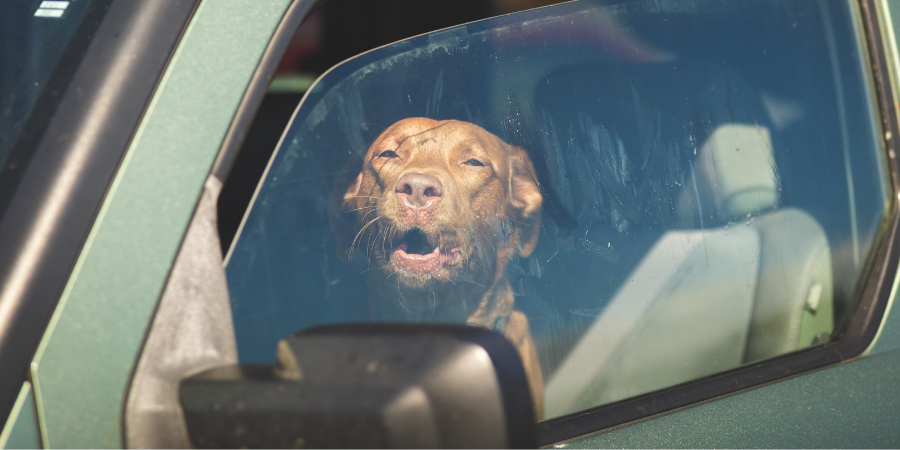Every year there are devastating reports in the media about dogs left in hot cars to suffer and even die. Sadly many owners are unaware of the tragic consequences from leaving a dog in a hot car.
However, even if they’re left for just a short while, in the shade and with a window cracked open, cars can heat up very quickly which can be extremely dangerous to our four-legged friends.
Cars can reach incredibly high temperatures within minutes of a car stopping. When a dog’s temperature goes above 40°C, it can trigger the start of irreversible damage to the brain and internal organs. Don’t take the risk. And if you think your dog does have heatstroke, contact your vet immediately.
So, is it illegal to leave a dog in a hot car? And what do you do if you see a dog struggling in a sweltering hot car?
Is it illegal to leave a dog in a hot car?
It is not illegal as such to leave a dog in a hot car, but owners are legally responsible for their pet’s health and welfare. If a dog became ill or sadly died due to being left in a hot car, owners could be charged with the offence of animal cruelty under the Animal Welfare Act 2006. This could lead to a prison sentence and/or a fine.
What to do if you see a dog in a hot car

Dog in distress
Step 1: Make an assessment of the situation. Is the dog showing signs of distress or heatstroke? If they are, dial 999 and ask for assistance.
Step 2: If the situation becomes critical for the dog and the police are too far away or unable to attend, many people’s instinct will be to break into the car to free the dog. If you decide to do this, please be aware that, without proper justification, it could be classed as criminal damage and you may need to be prepared to defend your actions in court.
Step 3: Tell the police what you intend to do and why, and take pictures and/or footage of the dog and the names and numbers of any witnesses to the incident. The law states that you have a lawful excuse to commit damage if you believe that the owner of the property would consent to the damage if they knew the circumstances (section 5(2)(a) Criminal Damage Act 1971). If you need legal advice, please speak to a lawyer.
Step 4: Once the dog is removed from the car, get someone to call a local vet immediately; they may ask you to come straight to them as an emergency. While you wait for advice, move the dog to a shaded/cool area and pour small amounts of cool water over their body. Don’t use ice-cold water as this could put them into shock. Allow the dog to drink small amounts of cool water and take them to the nearest vet as a matter of urgency, even if they seem to have recovered.
Dog not in distress
If you see a dog in a hot car but they do not seem like they are in distress or showing signs of heatstroke, read our advice.
Dogs most at risk of developing heatstroke are often overweight, have thicker or longer coats, are young or elderly, or are flat faced breeds (such as Pugs or Bulldogs). But it’s important to remember all dogs can suffer heatstroke.
Tips for pet owners in hot weather
- Avoid exercising your pet during hot weather. Go for gentle walks early in the morning or late in the evening when it’s cooler.
- Remember that pavements can get very hot and may burn your pets’ paws; check with your hand, if it’s too hot for your hand it’s too hot for your pet’s paws!
- Use pet-safe sun cream on white areas, hairless areas and skin that is exposed to the sun.
- If you are travelling in the car with your dog, keep them cool by opening the windows or tuning on the air conditioning, take plenty of cool water with you, plan doggy breaks, don’t travel during the hottest part of the day, and install shades so the vehicle isn’t too hot before you get in.
- Know the early signs of heatstroke which include panting, tiredness, less keen to play, drooling and vomiting and take immediate action. Stop exercising your dog, bring your dog inside into a cool area, give your dog a drink and seek veterinary advice immediately. Severe heatstroke can cause multiple seizures, complete loss of consciousness, loss of coordination, confusion and vomiting and diarrhoea with blood. If untreated it can be fatal.
- Ensure pets have access to shade and fresh drinking water at all times.
- Use a cooling mat or wrap an ice pack or frozen water bottle in a tea towel for your pet to lie on.
- Use cold treats from the fridge or make an ice lolly from pet-friendly ingredients.
- Finally, never leave your pet in a vehicle, caravan, conservatory or outbuilding in warm weather as they can quickly overheat. (Leaving your pet alone in a vehicle or tied up outside can also put them at greater risk of being stolen.)
Knowing what to do in an emergency situation can mean life or death. Download our first aid guide to help you know what to do in the most common pet emergency situations.
